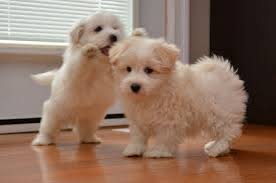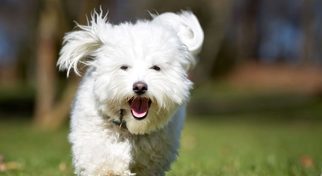Coton De Tulier
General
The name came about due to its coat, which is like cotton wool, and also from where it originated from, which was the seaport city of Tulear, now know as Toliara, and is located in Madascar. This little chap is related to the Maltese and Bechon Frise and is much alike in looks.
The Coton is basically known as a new breed as it was only recognized by the FCI in 1976 and only since 1996 by the UKC, both listed the breed under Companion dog. The AKC ofically recognized this breed in 2014, under Non-Sporting Group. This breed is in danger of extinction in its native Madagascar. The residents of Madagascare are very proud of this little dog and featured a tri-coloured Coton de Tulear on a postage stamp that was issued in 1974.
It seems as if this breed were bred solely as companions for people, however, there are stories that the breed first arrived in Madagascar several hundred years ago by ship, and in addition to being companions were used to hunt rats and mice on boats.
Known to be very friendly, intelligent and easy going, learns very quickly and loves nothing more than pleasing his person.
Many of this breed have the tendency of almost talking back to one, and are forever making a series of noises, such as grunts, whines and growls, which will just increase, if you talk back!
This little dog is very adaptable and easy to live with. It does require exercise, as all dogs do, however a daily walk will take care of its needs. They do very well at agility and learning tricks.
The name came about due to its coat, which is like cotton wool, and also from where it originated from, which was the seaport city of Tulear, now know as Toliara, and is located in Madascar. This little chap is related to the Maltese and Bechon Frise and is much alike in looks.
The Coton is basically known as a new breed as it was only recognized by the FCI in 1976 and only since 1996 by the UKC, both listed the breed under Companion dog. The AKC ofically recognized this breed in 2014, under Non-Sporting Group. This breed is in danger of extinction in its native Madagascar. The residents of Madagascare are very proud of this little dog and featured a tri-coloured Coton de Tulear on a postage stamp that was issued in 1974.
It seems as if this breed were bred solely as companions for people, however, there are stories that the breed first arrived in Madagascar several hundred years ago by ship, and in addition to being companions were used to hunt rats and mice on boats.
Known to be very friendly, intelligent and easy going, learns very quickly and loves nothing more than pleasing his person.
Many of this breed have the tendency of almost talking back to one, and are forever making a series of noises, such as grunts, whines and growls, which will just increase, if you talk back!
This little dog is very adaptable and easy to live with. It does require exercise, as all dogs do, however a daily walk will take care of its needs. They do very well at agility and learning tricks.
Is this the right dog for you?
It does seem as if this little dog is everything one could ask for in a small breed dog - happy go lucky, friendly, loves people, other animals and children, however, due to its absolute love for its people, it does not cope with being alone and tends to develop separation anxiety. Due to this it is very important that the time is taken when the dog is a pup to teach it Alone Time, and to keep this going throughout it's life, so that this terrible condition does not develop.
Research on the breed indicates that they can be hard to toilet train.
It does seem as if this little dog is everything one could ask for in a small breed dog - happy go lucky, friendly, loves people, other animals and children, however, due to its absolute love for its people, it does not cope with being alone and tends to develop separation anxiety. Due to this it is very important that the time is taken when the dog is a pup to teach it Alone Time, and to keep this going throughout it's life, so that this terrible condition does not develop.
Research on the breed indicates that they can be hard to toilet train.

Should you have 2 of the same, or 2 pups together?
On average the Coton does not tend to be aggressive to other dogs, however you must make sure that your dog has been well socialized so that it will accept another dog into the home.
When it comes to which sex get on better, your best bet is one male and one female (both sterilized), or 2 males together. Never two females. The vast majority of the time two females will get on well until about 8 - 9 months of age and thenm fighting for position tends to occur. When males have the odd altercation, it tends to be over quickly, but with females, it just intensifies and often the only solution is for one of the females to be rehomes. This is not just for this breed, but in general.
Having two pups from same litter is not a good idea. Most people think that the pups will be happier with a playmate and won’t fight if they are family.Your pup should be at least 5 months old, before you consider bringing in another pup. This allows the pups to grow to their full potential and not become over dependent on one another. The truth of the matter is that your two pups are likely to:
Bond with each other to the exclusion of you
On average the Coton does not tend to be aggressive to other dogs, however you must make sure that your dog has been well socialized so that it will accept another dog into the home.
When it comes to which sex get on better, your best bet is one male and one female (both sterilized), or 2 males together. Never two females. The vast majority of the time two females will get on well until about 8 - 9 months of age and thenm fighting for position tends to occur. When males have the odd altercation, it tends to be over quickly, but with females, it just intensifies and often the only solution is for one of the females to be rehomes. This is not just for this breed, but in general.
Having two pups from same litter is not a good idea. Most people think that the pups will be happier with a playmate and won’t fight if they are family.Your pup should be at least 5 months old, before you consider bringing in another pup. This allows the pups to grow to their full potential and not become over dependent on one another. The truth of the matter is that your two pups are likely to:
Bond with each other to the exclusion of you
- Will stress without the other dog being around
- Fight with each other
- Be more destructive and boisterous
- Two pups together often leads to one being more assertive and the other more submissive. This could well end up in a situation where the more submissive dog will never develop its full potential.
- Mature later
Do they get on with other dogs?
ght with each otherOn average, yes they do get on with other dogs. However it is always a good idea to attend puppy school and continue the socialization throughout the dogs life. Being such a small breed, care must be taken when playing with bigger breeds as it can get hurt.
ght with each otherOn average, yes they do get on with other dogs. However it is always a good idea to attend puppy school and continue the socialization throughout the dogs life. Being such a small breed, care must be taken when playing with bigger breeds as it can get hurt.
Do they get on with other animals?
They do not seem to present any problems getting on with cats and smaller animals, however we do suggest that you habituate them to small animals when they are pups, as if they story that they were used for ratters on-board ships in the past, there could be a high prey drive, so rather be careful.
They do not seem to present any problems getting on with cats and smaller animals, however we do suggest that you habituate them to small animals when they are pups, as if they story that they were used for ratters on-board ships in the past, there could be a high prey drive, so rather be careful.
Are they good with children?
Very, they love children, however given their small size, children have to be careful with them. It is a mistake to assume that all of this breed will like kids - ensure that early and continued socialization is done from being a pup with all ages and sizes of children.
Very, they love children, however given their small size, children have to be careful with them. It is a mistake to assume that all of this breed will like kids - ensure that early and continued socialization is done from being a pup with all ages and sizes of children.
Health
The health problems this breed tend to be prone to are allergies, ear infections, and hereditary eye diseases can cause blindness. They are also prone to bad hip joints and lameness as well as luxating patella. Heart disease is also listed as well as urinary stones and hypothyroidism.
“In today’s age, with the rising cost of veterinary care, it really is a wise decision to consider medical insurance for your pets. Depending on the plan you choose, you can ensure that if your pet does develop one of the health issues the breed is prone too, that you will be covered –additionally, just knowing that any accident your pet may have will be covered, will out-weigh the monthly insurance fee for most pet owners. Our own personal choice is Genricpet as they have a ‘no limit’ policy and their rates are comparable to the rest of the industry. To find out the questions and things to look for in a Medical Insurance, please just follow this link”
The health problems this breed tend to be prone to are allergies, ear infections, and hereditary eye diseases can cause blindness. They are also prone to bad hip joints and lameness as well as luxating patella. Heart disease is also listed as well as urinary stones and hypothyroidism.
“In today’s age, with the rising cost of veterinary care, it really is a wise decision to consider medical insurance for your pets. Depending on the plan you choose, you can ensure that if your pet does develop one of the health issues the breed is prone too, that you will be covered –additionally, just knowing that any accident your pet may have will be covered, will out-weigh the monthly insurance fee for most pet owners. Our own personal choice is Genricpet as they have a ‘no limit’ policy and their rates are comparable to the rest of the industry. To find out the questions and things to look for in a Medical Insurance, please just follow this link”
Do’s and Dont’s
Do’s
Don’t
Do’s
- Do get your pup from a KUSA registered breeder and do read the articles on Breeders and also choosing a pup
- Sterilize at approximately 6 months of age.
- Do take your pup for socialization - pups should start at 8 weeks of age and this should not be missed - lays the foundation for future social interactions.
- Do continue the socialiazation - keeps solid social skills in place
- Give daily, regular exercise.
- Supply chew toys and mental stimulation when left alone.
- From being a pup, practice Alone Time
- Allow your dog to be part of the family
- Give regular brushing and annual vacs.
- Take your dog for basic training and keep simple house rules in place
Don’t
- Don't use aversive training methods.
- Leave this breed outside alone – behaviour problems will develop


